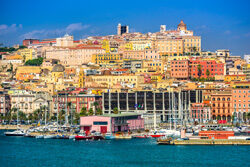
The castello or castle district is the oldest and highest part of the city and a good place to wander around. The roof of Bastione di San Remy is now an open terrace where you can enjoy great views of the city and sea beyond or have a drink at one of the bars. Inside is an exhibit area and concerts are sometimes held here, too. In the Castello district are the Romanesque Cathedral of Santa Maria and museum, the Archbishop’s Palace, and the Elephant and San Pancrazio Towers.
Only a few kolometres away from Cagliari you will find marvelous lagoons and endless sandy beaches where you can relax, stroll around or just sunbathe. A place where the stresses and strains of city life are easily forgotten. The city of Cagliari boasts a long coastline of eight miles, the Poetto, the popular beach of Cagliari, which becomes a center for meetings and nightlife in the hot summer evenings, thanks to the many restaurants and bars in the waterfront, from Sella del Diavolo (“Devil’s Saddle”) up to the coastline of Quartu Sant’Elena. Poetto is also the name of the district located on the western stretch of the strip between the beach and Saline di Molentargius (“Molentargius’s Salt Mine”). Another smaller beach is that of Calamosca near the Sant’Elia district. On the coast between Calamosca and Poetto beaches, among the cliffs of the Sella del Diavolo, lies Cala Fighera, a small bay.
The Molentargius-Saline Regional Natural Park, in the inner part of the province, is a rare example of an ecosystem in highly anthropized areas. It is one of the most important places in Europe for the extraordinary number of birds that shelter here. One-hundred-seventy-seven among 330 of Sardinia’s birds species live in the Molentargius Basin – more than a quarter of all European bird species. At certain times of the year, these can exceed 20,000 specimens. Among these: flamingos, herons and little egrets.